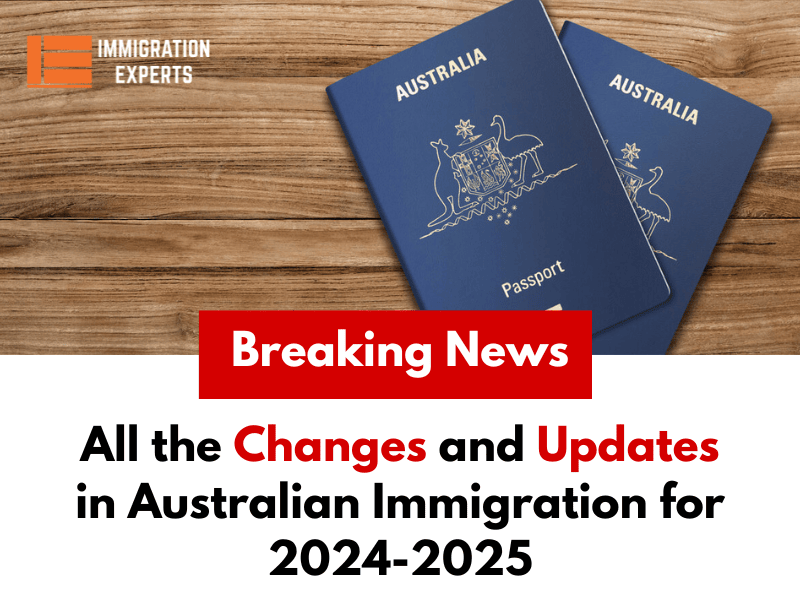051 8439995, 042 35911332

Starting from July 1, 2024, the Australian Government will implement significant modifications to the immigration system that will influence various visa schemes and requirements. These alterations will affect business sponsors, skilled migrants, and holders of temporary visas.
Things You Will Find In This Page
Western Australia’s New Designated Area Migration Agreement
Starting on July 1, 2024, Western Australia will introduce a new state-wide Designated Area Migration Agreement (DAMA).
This new WA DAMA, along with the existing State Nominated Migration Program, will allow up to 10,000 international workers to come to Western Australia each year to help fill important job shortages in the state.
Employers in Western Australia will still be able to use the job opportunities and benefits from the current DAMAs for specific regions. However, the new WA DAMA will offer a wider range of job options and benefits for employers all over the state.
Source: Department of Home Affairs
Ending Onshore Visa Hopping
The Minister for Home Affairs has issued a media release announcing additional modifications to the migration system, as outlined in the Migration Strategy. The purpose of these changes is to prevent the practice known as “visa hopping.” This occurs when individuals on temporary visas apply for additional temporary visas to remain in Australia longer, despite not having a viable route to permanent residency.
To curb visa hopping, the following changes will take effect from July 1, 2024:
- Visitor visa (subclass 600) holders will no longer be permitted to apply for Student (subclass 500) visas while onshore.
- Temporary Graduate (subclass 485) visa holders cannot apply for Student (subclass 500) visas while onshore.
New Australian Citizenship Application Fees From 1 July 2024
Starting July 1, 2024, the Australian government will increase the fees for obtaining or renewing passports and citizenship applications.

For Australian permanent residents aged 18 to 59, the fee for citizenship applications will rise from $540 to $560. The fee for citizenship through adoption will also increase, going from $345 to $360 for the first sibling and from $145 to $150 for additional siblings.
However, children under 16 who apply on the same form as their responsible parent will not be affected by these changes.
The government explained that the cost of applying for Australian citizenship varies based on factors such as the type of application, the applicant’s age, and their circumstances.
“Each year on July 1, the fees for citizenship applications are revised based on the consumer price index (CPI). The new fee rates will apply to all citizenship applications received by the Department of Home Affairs from 12 am (AEST) on July 1, 2024”. (Australian Government)
Citizenship Fees to Increase for Specific Groups of Foreigners
Starting soon, the citizenship application fees will rise for foreigners in specific categories, including children adopted under the Hague Convention or through bilateral arrangements. The new fees are as follows:
- Single application / First sibling when two or more siblings apply: $360
- Second and each subsequent sibling applying at the same time: $150
The new fees for Renunciation of Australian citizenship and Resumption of Australian citizenship will be set at $300 and $240, respectively.
Furthermore, there will be minor adjustments to concessional fees for pensioner concession card holders and their dependents, with the fee rising from $75 to $80.
“If you submit your application online at or after 12 am (AEST) on July 1, 2024, you will be charged the new fee. This applies no matter when you begin the application process. Your application is considered officially submitted once it has been received along with the payment”. (Australian Government)
Overview of Citizenship Fee Changes
| Fee Type | Current Fee | Fee from 1 July 2024 |
|---|---|---|
| Standard (Ages 18 to 59) | $540 | $560 |
| Dependent Child (15 or younger) | Nil | Nil |
| Concession Fee | $75 | $80 |
Exemptions from Australian Citizenship Application Fees
Fees that are currently either exempt or subject to minimal rounding adjustments will remain the same. The following groups will not need to pay the citizenship application fee:
- Former child migrants from Britain or Malta who came to Australia without their parents between September 22, 1947, and December 31, 1967, under the Commonwealth Child Migration Scheme.
- Individuals who have served for at least 90 days in the permanent forces of the Commonwealth of Australia.
- Individuals applying under the Statelessness provision of Section 21(8) of the Australian Citizenship Act 2007.
Source: Department of Home Affairs
Increase in TSMIT for Skilled Migrants

The Temporary Skilled Migration Income Threshold (TSMIT) has been raised from AUD 70,000 to AUD 73,150. This change demonstrates the government’s dedication to ensuring that temporary skilled workers receive fair compensation and to safeguarding the Australian labor market. To sponsor skilled workers, employers must follow this new threshold.
Updates to Conditions for 482, 457, and 494 Visas
Starting July 1, 2024, visa conditions 8107, 8607, and 8608 will be revised to address worker exploitation and enhance productivity, as detailed in the Migration Strategy.
If you hold a Temporary Work (Skilled) (subclass 457) visa, Temporary Skill Shortage (subclass 482) visa, or Skilled Employer Sponsored Regional (provisional) (subclass 494) visa and stop working for your sponsoring employer, you will have more time to find a new sponsor.
You will also have additional time to apply for another visa or to organize your departure from Australia.
These visa holders will be granted:
- Up to 180 days at a time, or
- A maximum of 365 days in total throughout the entire visa grant period.
Visa holders are allowed to work for different employers during this period.
They can also work in roles that were not specified in their previous sponsorship nomination. This will help ensure they can support themselves while seeking a new sponsor.
Visa holders must end their employment with their sponsoring employer before they can work for another employer unless they have an exemption.
They must continue working in their nominated occupation while working for their current sponsor.
Sponsors are still required to inform the department of any changes in circumstances within 28 days, including the cessation of sponsorship or a visa holder’s resignation.
Visa holders must not engage in any work that conflicts with the license or registration requirements for their nominated occupation, including any associated conditions or requirements.
The new rules apply to visa holders who are already in the system as well as to those who receive a visa on or after July 1, 2024. Any periods during which a visa holder ceased working for their sponsor before July 1, 2024, will not be counted towards the new timeframes outlined above.
The Australian Government’s New Migration Strategy for 2024
The Australian government has unveiled its new immigration changes, presenting a refreshed vision for the country’s migration system and key changes to expect in 2024.
1. Introduction of a New Skills in Demand Visa
The Australian government is launching a new Skills in Demand visa to boost worker mobility in the labor market, featuring three specific pathways:
a. Specialist Skills Pathway
- For highly skilled migrants who significantly enhance Australia’s productivity.
- Requires a minimum annual salary of AUD 135,000, and at least equal to Australian workers in the same job.
- Open to all occupations except trades workers, machinery operators, drivers, and laborers.
b. Core Skills Pathway
- For those in occupations listed on the new Core Skills Occupation list, identifying jobs in shortage as per Jobs and Skills Australia.
- Must earn at least the Temporary Skilled Migration Income Threshold (TSMIT).
c. Essential Skills Pathway
- For workers earning less than AUD 70,000 with essential skills.
- Currently under development, with workers sponsored through labor agreements.
Overview of the New Skills in Demand Visa

The TSS 482 visa is being replaced by this new visa, which includes:
- Three Pathways: Specialist Skills, Core Skills, and Essential Skills.
- Duration: A 4-year stay is permitted for all streams under this visa.
- Processing Times: Aims for a median processing time of 21 days.
- Labor Market Testing: No longer requires advertising positions through Workforce Australia, extending ad validity from 4 to 6 months.
- Employee Mobility: Visa holders get 180 days to find a new sponsor if they leave their current job, up from 60 days, and can work during this period.
- Permanent Residency Pathways: All visa holders can eventually apply for permanent residency, with any time spent with approved employers counting towards eligibility, unlike the current 186 visa Transition stream.
- Employer Costs: The government is considering spreading out employer fees, like those for the Skilling Australia Fund, to monthly or quarterly payments to reduce upfront costs.
- Public Sponsor Register: A register of approved sponsors will be created, listing the number of sponsored workers and their occupations, helping migrants find new sponsors.
2. Reform of the Points Test and Introduction of a New Talent and Innovation Visa
The Points Test for permanent skilled migration will be reviewed and could be reformed by the government.
A new Talent and Innovation visa will also be launched to bring in migrants who can stimulate growth in critical areas of Australia’s economy.
Points Test Reform
- Review and Consultation: The current points test will undergo review and consultation to develop a new, analysis-based points test. This will help identify the independent migrants who can make the greatest contributions to Australia.
- Faster Pathway to Permanent Residence: This new pathway will provide quicker access to permanent residency for graduates working in skilled jobs.
New Talent and Innovation Visa
- Streamlined Pathway: A new Talent and Innovation visa will be created, offering a simplified route for highly talented migrants to come to Australia.
- Limited Numbers: This visa aims to attract a relatively small number of highly skilled individuals who can significantly contribute to Australia’s growth sectors.
Impact on Existing Programs
- Business Innovation and Investment Program: No new allocations will be made for this program while the government reviews the Talent and Innovation visa.
3. Changes to Student Subclass 500 Visa in 2024
In 2024, the Australian government will introduce new rules for the Student SC500 visa, focusing on the Genuine Student (GS) requirement and higher English language standards.

New Genuine Student (GS) Requirement
- What’s Changing: The Genuine Temporary Entrant (GTE) requirement will be replaced with the new Genuine Student (GS) requirement.
- What You Need to Do: You will need to provide proof that you are a genuine student, which helps ensure that visa applications are from real students.
Higher English Language Requirements
Starting early in 2024, the English language requirements for Student visas will be increased:
- For Student SC500 Visas: The IELTS score needed will go from 5.5 to 6.0, or an equivalent test score.
- For English Language Intensive Course for Overseas Students (ELICOS): The IELTS score required will increase from 4.5 to 5.0.
- For University Foundation or Pathway Programs: A minimum IELTS score of 5.5, or an equivalent, will be necessary.
Changes to Confirmation of Enrolment
- New Rule: You will need to finish 6 months of your course before you can get a Concurrent Confirmation of Enrolment.
Increased Proof of Savings
- What’s New: You will have to show a higher amount of savings when you apply for a student visa to prove you have enough money for your stay.
These changes are designed to ensure that international students are genuinely coming to Australia for their studies and are well-prepared for their courses.
Summary Table of Changes
| Change | Current Requirement | New Requirement (from early 2024) |
| GTE to GS Requirement | Genuine Temporary Entrant (GTE) | Genuine Student (GS) |
| English Test Score for SC500 | IELTS 5.5 | IELTS 6.0 |
| English Test Score for ELICOS | IELTS 4.5 | IELTS 5.0 |
| English Test Score for Pathway | Varies | IELTS 5.5 |
| Concurrent Confirmation of Enrolment | Issued anytime during the course | Issued only after completing 6 months |
| Proof of Savings | Current amount | Increased amount |
These updates aim to improve the quality of the student visa program and support better learning and work opportunities for international students in Australia.
4. Updates to the Temporary Graduate Subclass 485 Visa for 2024
In 2024, there will be several updates to the Temporary Graduate Subclass 485 visa. These changes are designed to streamline the visa program and create better opportunities for skilled migration.
New Duration of the Temporary Graduate Visa
- Bachelor’s Degree or Master’s by Coursework: The visa will now be valid for 2 years.
- Master’s by Research or PhD: The visa will be extended to 3 years.
- Students in Regional Areas: You can apply for a second visa for 1-2 additional years depending on your location.
New Opportunities with the Skills in Demand Visa
- Pathway to Permanent Residency: If you work in a skilled job during your Temporary Graduate visa period, you may be able to apply for the new 4-year Skills in Demand visa. This visa offers a clearer path to permanent residency.
- Work Experience Requirements: The work experience requirements for the new Skills in Demand visa and the current TSS visa will be updated to help Temporary Graduate SC485 visa holders transition to a skilled migration visa more effectively.
New Age Limit for Applicants
- Age Restriction: Applicants for the Temporary Graduate visa will need to be under 35 years old, lowered from the current limit of 50 years.
Increased English Language Requirements
- English Test Score: The required IELTS score for the Temporary Graduate SC485 visa will increase from 6.0 to 6.5, or an equivalent test score.
Summary Table of Changes
| Change | Current Requirement | New Requirement (from 2024) |
| Visa Duration for Bachelor or Coursework Master’s | 3 years | 2 years |
| Visa Duration for Research Master’s or PhD | 4 years | 3 years |
| Additional Visa for Regional Students | Not available | 1-2 years depending on the location |
| Skills in Demand Visa Pathway | Not available | New 4-year visa available for skilled jobs |
| Age Limit for SC485 Visa Applicants | Up to 50 years | Under 35 years |
| English Language Requirements for Subclass 485 | IELTS 6.0 | IELTS 6.5 |
These updates aim to provide more opportunities for international students and skilled workers while supporting Australia’s migration needs.
Detailed Overview of Changes
| Aspect | Details Before 2024 | Changes from 2024 |
| Temporary Graduate Visa Duration | 3 years for Bachelor’s or Master’s; 4 years for PhD | 2 years for a Bachelor’s or Master’s; 3 years for PhD |
| Regional Area Visa Extension | Not available | 1-2 years extension depending on location |
| Skills in Demand Visa | Not available | New visa with a 4-year stay and a clear path to PR |
| Age Limit for Visa Applicants | Up to 50 years | Under 35 years |
| English Test Score | IELTS 6.0 for Subclass 485 | IELTS 6.5 for Subclass 485 |
| Proof of Savings | Current amount | Increased amount |
408 COVID Visa Closure Announcement
Pandemic Event 408 Covid visa holders can apply for a subsequent visa from September 2, 2023, until the visa program closes in February 2024.
From September 2, 2023, new applicants will no longer be able to apply for the Pandemic Event visa. Visa applications submitted before September 2, 2023, will have a validity of 12 months, and Temporary Graduate 485 visa holders will have up to 2 years.
When applying for a visa on or after September 2, 2023, you need to have a Pandemic Event visa that expires within 28 days.
Applications lodged on or after September 2, 2023, will be assessed for a stay of up to 6 months. Beginning September 2, 2023, the Pandemic Event visa will only be granted to existing Pandemic Event visa holders.
